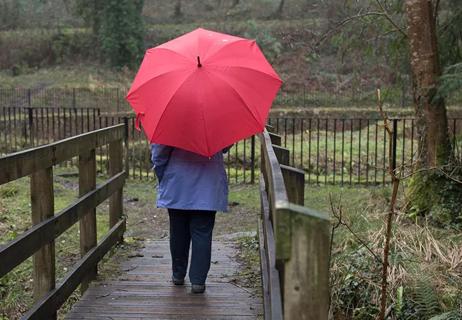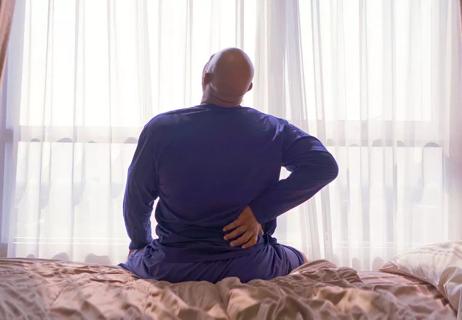Getting the facts straight about osteoarthritis

Have you ever predicted a storm from just feeling it in your joints? You’ve probably heard other people say it, too. But is there any truth behind this common statement?
Advertisement
Cleveland Clinic is a non-profit academic medical center. Advertising on our site helps support our mission. We do not endorse non-Cleveland Clinic products or services. Policy
There’s a lot of misinformation about osteoarthritis (OA) pain and treatment, but rheumatologist M. Elaine Husni, MD, MPH, helps debunks some common misconceptions:
Fact: Other conditions, such as tendonitis, bursitis or other soft-tissue injuries also cause joint pain. These are common structures that are located around the actual joints that can cause pain and swelling and mimic joint pain.
Osteoarthritis is the most common type of arthritis, especially in patients over 50 years old. Your symptoms may include swelling, pain and you may have difficulty moving your joints. OA most commonly starts in your 50s and worsens over time. However, there are many structures around the joints that can also cause pain in the same areas such as tendonitis, bursitis or soft tissue injuries. Evaluation by a rheumatologist will lead to the right diagnosis and treatment.
Fact: Although many believe that a twinge in the knee or knuckle can predict rain, there’s no hard scientific evidence that dampness or humidity intensifies arthritis symptoms.
Fact: Regular, sensible exercise actually may help your arthritis, although arthritic joints sometimes need a short period of rest followed by a gradual return to activity. It’s important to maintain your strength and range of motion in your joints. We encourage movement of your joints even if you have arthritis.
Advertisement
“Be careful,” warns Dr. Husni. “Know your limits and start with 20 minutes at a time. Your doctor can guide you and suggest exercise that’s gentler on the joints if your current exercise routine causes pain.”
Fact: Arthritis has no cure, but medications and lifestyle changes can effectively manage symptoms and permit normal activity. However, paying attention to what food you’re putting in your body can help ease your symptoms.
“Make sure to increase your fresh fruits and vegetables,” says Dr. Husni. “Some fruits and veggies have anti-inflammatory properties that help soothe your pain.”
Talk to your rheumatologist or dietitian to help get you started with a healthy diet.
Fact: Both cold and heat are useful for arthritis. You do what feels good for your joint discomfort.
“Applying ice at night can ease joint inflammation arising from daily activities,” says Dr. Husni. “Applying heat in the morning can relax the muscles that move stiff joints.”
If you’re applying ice to your sore joints, apply an ice pack for 20 minutes at a time. If you don’t have any ice packs on hand, grab a bag of frozen vegetables or throw some ice cubes into a plastic baggie.
A heating pad does wonders for sore joints, too. If no heating pad is available, microwave a damp washcloth for about 15 seconds and place it on the affected joints to soothe them. Don’t be afraid to soak in a warm bath or hop in a warm shower for some pain relief.
Fact: Glucosamine, a dietary supplement that helps keep joints healthy, has been shown to benefit only a subset of people with osteoarthritis, possibly by stimulating the regrowth of worn out cartilage. However, the study results do not support the use of glucosamine for everyone with arthritis.
“We advise patients to take glucosamine with chondroitin for three months to see if it makes any difference,” says Dr. Husni. “If so, continue using it; if not, don’t waste your money and look for other options.”
“A diagnosis of arthritis doesn’t mean the end of an active lifestyle,” says Dr. Husni. “When treating OA, our goal is to help you learn to manage all aspects of pain and to increase your joint mobility and strength.”
Collaborate with your rheumatologist to find what works best for you and your lifestyle.
Advertisement
Learn more about our editorial process.
Advertisement

Barometric pressure can play a role in joint pain, but that doesn’t mean you have to live with it

Find the right sleep position to tame your joint pain

Several options to help get you moving

Even one less pound helps preserve hips and knees

Take steps now to keep them in good working order

Plus, ways to keep your bones healthy and strong!

Bone health starts with proper nutrition, exercise and healthy lifestyle choices

Eating well can help reduce inflammation when you have endometriosis

If you’re feeling short of breath, sleep can be tough — propping yourself up or sleeping on your side may help

If you fear the unknown or find yourself needing reassurance often, you may identify with this attachment style

If you’re looking to boost your gut health, it’s better to get fiber from whole foods